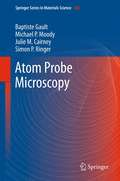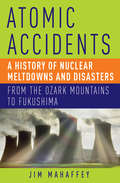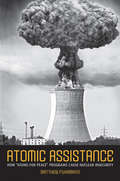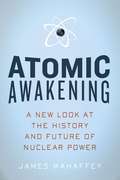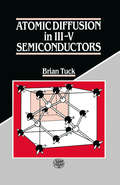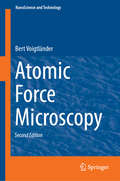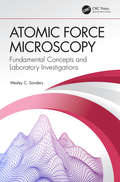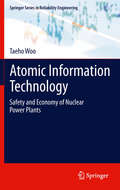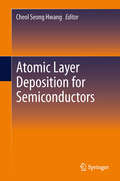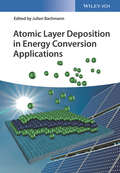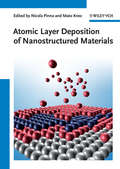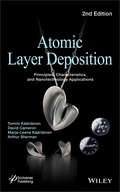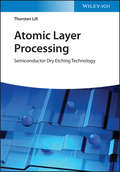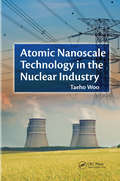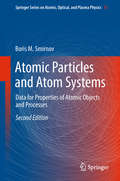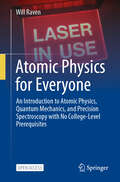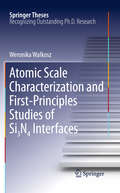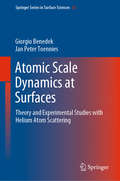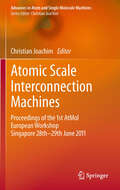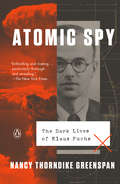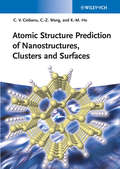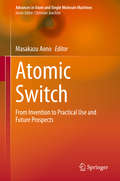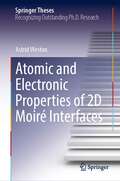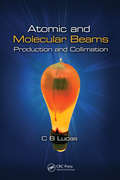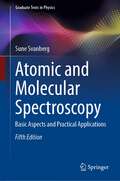- Table View
- List View
Atom Probe Microscopy (Springer Series in Materials Science #160)
by Michael P. Moody Julie M. Cairney Baptiste Gault Simon P. RingerAtom probe microscopy enables the characterization of materials structure and chemistry in three dimensions with near-atomic resolution. This uniquely powerful technique has been subject to major instrumental advances over the last decade with the development of wide-field-of-view detectors and pulsed-laser-assisted evaporation that have significantly enhanced the instrument's capabilities. The field is flourishing, and atom probe microscopy is being embraced as a mainstream characterization technique. This book covers all facets of atom probe microscopy--including field ion microscopy, field desorption microscopy and a strong emphasis on atom probe tomography. Atom Probe Microscopy is aimed at researchers of all experience levels. It will provide the beginner with the theoretical background and practical information necessary to investigate how materials work using atom probe microscopy techniques. This includes detailed explanations of the fundamentals and the instrumentation, contemporary specimen preparation techniques, experimental details, and an overview of the results that can be obtained. The book emphasizes processes for assessing data quality, and the proper implementation of advanced data mining algorithms. Those more experienced in the technique will benefit from the book as a single comprehensive source of indispensable reference information, tables and techniques. Both beginner and expert will value the way that Atom Probe Microscopy is set out in the context of materials science and engineering, and includes references to key recent research outcomes.
Atomic Accidents: A History of Nuclear Meltdowns and Disasters: From the Ozark Mountains to Fukushima
by James MahaffeyFrom the moment radiation was discovered in the late nineteenth century, nuclear science has had a rich history of innovative scientific exploration and discovery, coupled with mistakes, accidents, and downright disasters. Mahaffey, a long-time advocate of continued nuclear research and nuclear energy, looks at each incident in turn and analyzes what happened and why, often discovering where scientists went wrong when analyzing past meltdowns. Every incident has lead to new facets in understanding about the mighty atom--and Mahaffey puts forth what the future should be for this final frontier of science that still holds so much promise.
Atomic Assistance
by Matthew FuhrmannNuclear technology is dual use in nature, meaning that it can be used to produce nuclear energy or to build nuclear weapons. Despite security concerns about proliferation, the United States and other nuclear nations have regularly shared with other countries nuclear technology, materials, and knowledge for peaceful purposes. In Atomic Assistance, Matthew Fuhrmann argues that governments use peaceful nuclear assistance as a tool of economic statecraft. Nuclear suppliers hope that they can reap the benefits of foreign aid-improving relationships with their allies, limiting the influence of their adversaries, enhancing their energy security by gaining favorable access to oil supplies-without undermining their security. By providing peaceful nuclear assistance, however, countries inadvertently help spread nuclear weapons. Fuhrmann draws on several cases of "Atoms for Peace," including U.S. civilian nuclear assistance to Iran from 1957 to 1979; Soviet aid to Libya from 1975 to 1986; French, Italian, and Brazilian nuclear exports to Iraq from 1975 to 1981; and U.S. nuclear cooperation with India from 2001 to 2008. He also explores decision making in countries such as Japan, North Korea, Pakistan, South Africa, and Syria to determine why states began (or did not begin) nuclear weapons programs and why some programs succeeded while others failed. Fuhrmann concludes that, on average, countries receiving higher levels of peaceful nuclear assistance are more likely to pursue and acquire the bomb-especially if they experience an international crisis after receiving aid.
Atomic Awakening: A New Look at the History and Future of Nuclear Power
by James MahaffeyThe American public's introduction to nuclear technology was manifested in destruction and death. With Hiroshima and the Cold War still ringing in our ears, our perception of all things nuclear is seen through the lens of weapons development. Nuclear power is full of mind-bending theories, deep secrets, and the misdirection of public consciousness, some deliberate, some accidental. The result of this fixation on bombs and fallout is that the development of a non-polluting, renewable energy source stands frozen in time. It has been said that if gasoline were first used to make napalm bombs, we would all be driving electric cars. Our skewed perception of nuclear power is what makes James Mahaffey's new look at the extraordinary paradox of nuclear power so compelling. From medieval alchemy to Marie curie, Albert Einstein, and the Manhattan Project, atomic science is far from the spawn of a wicked weapons program. The discovery that the atom can be split brought forth the ultimate puzzle of the modern age: Now that the energy of the universe is available to us, how do we use it? For death and destruction? Or as a fuel for our society that has minimal impact on the environment and future generations? Outlining nuclear energy's discovery and applications throughout history, Mahaffey's brilliant and accessible book is essential to understanding the astounding phenomenon of nuclear power in an age where renewable energy and climate change have become the defining concerns of the twenty-first century.
Atomic Diffusion in III-V Semiconductors
by Brian TuckIII-V semiconductors, of which gallium arsenide is the best known, have been important for some years and appear set to become much more so in the future. They have principally contributed to two technologies: microwave devices and optoelectronics. Recent advances in the production of thin layers have made possible a whole new range of devices based on multi-quantum wells. The heat treatments used in the manufacture of semiconductor devices means that some diffusion must take place. A good understanding of diffusion processes is therefore essential to maintain control over the technology. Atomic Diffusion in III-V Semiconductors presents a lucid account of the experimental work that has been carried out on diffusion in III-Vs and explores the advanced models that explain the results. A review of the III-V group of semiconductors outlines the special properties that make them so attractive for some types of devices. Discussion of the basic elements of diffusion in semiconductors provides the theory necessary to understand the subject in depth, and the book gives hints on how to assess the published data. Chapters on diffusion of shallow donors, shallow acceptors, transition elements, and very fast-diffusing elements provide a critical review of published works. The book also presents the neglected subject of self-diffusion, including a section on superlattices. Atomic Diffusion in III-V Semiconductors will be of interest to research workers in semiconductor science and technology, and to postgraduate students in physics, electronics, and materials science.
Atomic Force Microscopy (NanoScience and Technology)
by Bert VoigtländerThis book explains the operating principles of atomic force microscopy with the aim of enabling the reader to operate a scanning probe microscope successfully and understand the data obtained with the microscope. This enhanced second edition to "Scanning Probe Microscopy" (Springer, 2015) represents a substantial extension and revision to the part on atomic force microscopy of the previous book. Covering both fundamental and important technical aspects of atomic force microscopy, this book concentrates on the principles the methods using a didactic approach in an easily digestible manner. While primarily aimed at graduate students in physics, materials science, chemistry, nanoscience and engineering, this book is also useful for professionals and newcomers in the field, and is an ideal reference book in any atomic force microscopy lab.
Atomic Force Microscopy: Fundamental Concepts and Laboratory Investigations
by Wesley C. SandersThis book focuses primarily on the atomic force microscope and serves as a reference for students, postdocs, and researchers using atomic force microscopes for the first time. In addition, this book can serve as the primary text for a semester-long introductory course in atomic force microscopy. There are a few algebra-based mathematical relationships included in the book that describe the mechanical properties, behaviors, and intermolecular forces associated with probes used in atomic force microscopy. Relevant figures, tables, and illustrations also appear in each chapter in an effort to provide additional information and points of interest. This book includes suggested laboratory investigations that provide opportunities to explore the versatility of the atomic force microscope. These laboratory exercises include opportunities for experimenters to explore force curves, surface roughness, friction loops, conductivity imaging, and phase imaging.
Atomic Information Technology: Safety and Economy of Nuclear Power Plants (Springer Series in Reliability Engineering)
by Taeho WooAtomic Information Technology revaluates current conceptions of the information technology aspects of the nuclear industry. Economic and safety research in the nuclear energy sector are explored, considering statistical methods which incorporate Monte-Carlo simulations for practical applications. Divided into three sections, Atomic Information Technology covers: Atomic economics and management, Atomic safety and reliability, and Atomic safeguarding and security. Either as a standalone volume or as a companion to conventional nuclear safety and reliability books, Atomic Information Technology acts as a concise and thorough reference on statistical assessment technology in the nuclear industry. Students and industry professionals alike will find this a key tool in expanding and updating their understanding of this industry and the applications of information technology within it.
Atomic Layer Deposition for Semiconductors
by Cheol Seong HwangOffering thorough coverage of atomic layer deposition (ALD), this book moves from basic chemistry of ALD and modeling of processes to examine ALD in memory, logic devices and machines. Reviews history, operating principles and ALD processes for each device.
Atomic Layer Deposition in Energy Conversion Applications
by Julien BachmannCombining the two topics for the first time, this book begins with an introduction to the recent challenges in energy conversion devices from a materials preparation perspective and how they can be overcome by using atomic layer deposition (ALD). By bridging these subjects it helps ALD specialists to understand the requirements within the energy conversion field, and researchers in energy conversion to become acquainted with the opportunities offered by ALD. With its main focus on applications of ALD for photovoltaics, electrochemical energy storage, and photo- and electrochemical devices, this is important reading for materials scientists, surface chemists, electrochemists, electrotechnicians, physicists, and those working in the semiconductor industry.
Atomic Layer Deposition of Nanostructured Materials
by Mato Knez Nicola PinnaAtomic layer deposition, formerly called atomic layer epitaxy, was developed in the 1970s to meet the needs of producing high-quality, large-area fl at displays with perfect structure and process controllability. Nowadays, creating nanomaterials and producing nanostructures with structural perfection is an important goal for many applications in nanotechnology. As ALD is one of the important techniques which offers good control over the surface structures created, it is more and more in the focus of scientists. The book is structured in such a way to fi t both the need of the expert reader (due to the systematic presentation of the results at the forefront of the technique and their applications) and the ones of students and newcomers to the fi eld (through the first part detailing the basic aspects of the technique). This book is a must-have for all Materials Scientists, Surface Chemists, Physicists, and Scientists in the Semiconductor Industry.
Atomic Layer Deposition: Principles, Characteristics, and Nanotechnology Applications
by Arthur Sherman David Cameron Marja-Leena Kääriäinen Tommi KääriäinenSince the first edition was published in 2008, Atomic Layer Deposition (ALD) has emerged as a powerful, and sometimes preferred, deposition technology. The new edition of this groundbreaking monograph is the first text to review the subject of ALD comprehensively from a practical perspective. It covers ALD's application to microelectronics (MEMS) and nanotechnology; many important new and emerging applications; thermal processes for ALD growth of nanometer thick films of semiconductors, oxides, metals and nitrides; and the formation of organic and hybrid materials.
Atomic Layer Processing: Semiconductor Dry Etching Technology
by Thorsten LillLearn about fundamental and advanced topics in etching with this practical guide Atomic Layer Processing: Semiconductor Dry Etching Technology delivers a hands-on, one-stop resource for understanding etching technologies and their applications. The distinguished scientist, executive, and author offers readers in-depth information on the various etching technologies used in the semiconductor industry, including thermal, isotropic atomic layer, radical, ion-assisted, and reactive ion etching. The book begins with a brief history of etching technology and the role it has played in the information technology revolution, along with a collection of commonly used terminology in the industry. It then moves on to discuss a variety of different etching techniques, before concluding with discussions of the fundamentals of etching reactor design and newly emerging topics in the field such as the role played by artificial intelligence in the technology. Atomic Layer Processing includes a wide variety of other topics as well, all of which contribute to the author’s goal of providing the reader with an atomic-level understanding of dry etching technology sufficient to develop specific solutions for existing and emerging semiconductor technologies. Readers will benefit from: A complete discussion of the fundamentals of how to remove atoms from various surfaces An examination of emerging etching technologies, including laser and electron beam assisted etching A treatment of process control in etching technology and the role played by artificial intelligence Analyses of a wide variety of etching methods, including thermal or vapor etching, isotropic atomic layer etching, radical etching, directional atomic layer etching, and more Perfect for materials scientists, semiconductor physicists, and surface chemists, Atomic Layer Processing will also earn a place in the libraries of engineering scientists in industry and academia, as well as anyone involved with the manufacture of semiconductor technology. The author’s close involvement with corporate research & development and academic research allows the book to offer a uniquely multifaceted approach to the subject.
Atomic Nanoscale Technology in the Nuclear Industry (Devices, Circuits, and Systems)
by Taeho WooDevelopments at the nanoscale are leading to new possibilities and challenges for nuclear applications in areas ranging from medicine to international commerce to atomic power production/waste treatment. Progress in nanotech is helping the nuclear industry slash the cost of energy production. It also continues to improve application reliability and safety measures, which remain a critical concern, especially since the reactor disasters in Japan. Exploring the new wide-ranging landscape of nuclear function, Atomic Nanoscale Technology in the Nuclear Industry details the breakthroughs in nanoscale applications and methodologies that are revolutionizing power production, biotechnology, and material science. Developments in atomic nanoscale technology have given us the ability to: Use ion beams to Investigate and optimize radiation energy losses at the nanoscopic level Assess nanoscopic safety circumstances involved in a reactor failure Analyze characteristics of nuclear spacecraft operating in the nanogravity of deep space Evaluate light collection enhancement for digital X-ray detection Apply brachytherapy using radioisotopes for cancer therapy Treat nuclear waste at the nanoscopic level Use systems-thinking decision making to analyze financial progress of nanotech in the energy industry Assess safety (and safety management methods) for nuclear nanomaterials used in plant operations Representing a first step in multi-combinatorial research, this text incorporates advanced studies that use Monte Carlo and solid-state measurement (including radiation detection) methods. Researchers used these to demonstrate the potential to upgrade methods of radiation protection and nuclear reactor operation (safety, waste disposal, etc.). The author also addresses how we can use nanotechnology to address industrial concerns and enhance nuclear medicine techniques. He highlights several nanomaterial systems and devices to illustrate developments in this area. About the Author: Taeho Woo launched the specialized field of atomic multinology (interdisciplinary research of nuclear technology), which combines the application of information technology, biotechnology, and nanotechnology in the nuclear industry.
Atomic Particles and Atom Systems: Data for Properties of Atomic Objects and Processes (Springer Series on Atomic, Optical, and Plasma Physics #51)
by Boris M. SmirnovThis book presents physical units and widely used physical formulas, which are given together with conversion factors in various units. It includes frequently used atomic spectra and data for atoms, ions and molecules, as well as potential curves for diatomic molecules, and provides numerical parameters for transport phenomena in gases and plasmas. Further, the rate constants of a number of processes in atmospheric ionized air have been added to this second edition of the book. The numerical data has been selected from the information on atoms, atomic systems, atomic processes and models for atomic physics in this area, and the numerical parameters of atoms, ions and atom systems are included in periodical tables of elements.
Atomic Physics for Everyone: An Introduction to Atomic Physics, Quantum Mechanics, and Precision Spectroscopy with No College-Level Prerequisites
by Will RavenThis open access textbook introduces beginning undergraduate students and high school students to the world of quantum mechanics and atomic spectroscopy. Requiring no previous knowledge of physics and no math beyond basic algebra and sines and cosines, this book focuses on concepts to make the excitement of atomic physics more accessible for learners than ever before. It comes replete with learning goals, exercises and solutions, and an optional experimental component, making this text readily adoptable for both the classroom and the undergraduate lab. The book takes the reader on a lively and engaging tour through topics at the forefront of current science, including photons, quantum numbers, atomic energy levels, some different spectroscopy techniques, electronic structure, atomic notation, angular momentum, hyperfine structure, isotope shifts, the strong force, an introduction to the Standard Model of Particle Physics, and more. This is an open access book.
Atomic Scale Characterization and First-Principles Studies of Si₃N₄ Interfaces (Springer Theses)
by Weronika WalkoszThis thesis presents results from a combined atomic-resolution Z-contrast and annular bright-field imaging and electron energy loss spectroscopy in the Scanning Transmission Electron Microscopy, as well as first principles studies of the interfaces between crystalline β--Si3N4 and amorphous (i) CeO2-x as well as (ii) SiO2 intergranular film (IGF). These interfaces are of a great fundamental and technological interest because they play an important role in the microstructural evolution and mechanical properties of Si3N4 ceramics used in many high temperature and pressure applications. The main contribution of this work is its detailed description of the bonding characteristics of light atoms, in particular oxygen and nitrogen, at these interfaces, which has not been achieved before. The atomic-scale information on the arrangement of both light and heavy atoms is critical for realistic modeling of interface properties, such as interface strength and ion transport, and will facilitate increased control over the performance of ceramic and semiconductor materials for a wide-range of applications.
Atomic Scale Dynamics at Surfaces: Theory and Experimental Studies with Helium Atom Scattering (Springer Series in Surface Sciences #63)
by Giorgio Benedek Jan Peter ToenniesExperimental advances in helium atom scattering spectroscopy over the last forty years have allowed the measurement of surface phonon dispersion curves of more than 200 different crystal surfaces and overlayers of insulators, semiconductors and metals. The first part of the book presents, at a tutorial level, the fundamental concepts and methods in surface lattice dynamics, and the theory of atom-surface interaction and inelastic scattering in their various approximations, up to the recent electron-phonon theory of helium atom scattering from conducting surfaces. The second part of the book, after introducing the experimentalist to He-atom spectrometers and the rich phenomenology of helium atom scattering from corrugated surfaces, illustrates the most significant experimental results on the surface phonon dispersion curves of various classes of insulators, semiconductors, metals, layered crystals, topological insulators, complex surfaces, adsorbates, ultra-thin films and clusters. The great potential of helium atom scattering for the study of atomic scale diffusion, THz surface collective excitations, including acoustic surface plasmons, and the future prospects of helium atom scattering are presented in the concluding chapters. The book will be valuable reading for all researchers and graduate students interested in dynamical processes at surfaces.
Atomic Scale Interconnection Machines: Proceedings of the 1st AtMol European Workshop Singapore 28th-29th June 2011 (Advances in Atom and Single Molecule Machines)
by Christian JoachimThis volume documents the first International Workshop on Atomic Scale Interconnection Machines organised by the European Integrated Project AtMol in June 2011 in Singapore. The four sessions, discussed here in revised contributions by high level speakers, span the subjects of multi-probe UHV instrumentation, atomic scale nano-material nanowires characterization, atomic scale surface conductance measurements, surface atomic scale mechanical machineries. This state-of-the-art account brings academic researchers and industry engineers access to the tools they need to be at the forefront of the atomic scale technology revolution.
Atomic Spy: The Dark Lives of Klaus Fuchs
by Nancy Thorndike Greenspan"Nancy Greenspan dives into the mysteries of the Klaus Fuchs espionage case and emerges with a classic Cold War biography of intrigue and torn loyalties. Atomic Spy is a mesmerizing morality tale, told with fresh sources and empathy." --Kai Bird, author of The Good Spy and coauthor of American Prometheus: The Triumph and Tragedy of J. Robert OppenheimerThe gripping biography of a notorious Cold War villain--the German-born British scientist who handed the Soviets top-secret American plans for the plutonium bomb--showing a man torn between conventional loyalties and a sense of obligation to a greater good.German by birth, British by naturalization, Communist by conviction, Klaus Fuchs was a fearless Nazi resister, a brilliant scientist, and an infamous spy. He was convicted of espionage by Britain in 1950 for handing over the designs of the plutonium bomb to the Russians, and has gone down in history as one of the most dangerous agents in American and British history. He put an end to America's nuclear hegemony and single-handedly heated up the Cold War. But, was Klaus Fuchs really evil?Using archives long hidden in Germany as well as intimate family correspondence, Nancy Thorndike Greenspan brings into sharp focus the moral and political ambiguity of the times in which Fuchs lived and the ideals with which he struggled. As a university student in Germany, he stood up to Nazi terror without flinching, and joined the Communists largely because they were the only ones resisting the Nazis. After escaping to Britain in 1933, he was arrested as a German émigré--an "enemy alien"--in 1940 and sent to an internment camp in Canada. His mentor at university, renowned physicist Max Born, worked to facilitate his release. After years of struggle and ideological conflict, when Fuchs joined the atomic bomb project, his loyalties were firmly split. He started handing over top secret research to the Soviets in 1941, and continued for years from deep within the Manhattan Project at Los Alamos. Greenspan's insights into his motivations make us realize how he was driven not just by his Communist convictions but seemingly by a dedication to peace, seeking to level the playing field of the world powers.With thrilling detail from never-before-seen sources, Atomic Spy travels across the Germany of an ascendant Nazi party; the British university classroom of Max Born; a British internment camp in Canada; the secret laboratories of Los Alamos; and Eastern Germany at the height of the Cold War. Atomic Spy shows the real Klaus Fuchs--who he was, what he did, why he did it, and how he was caught. His extraordinary life is a cautionary tale about the ambiguity of morality and loyalty, as pertinent today as in the 1940s.
Atomic Structure Prediction of Nanostructures, Clusters and Surfaces
by Cai-Zhuan Wang Cristian V. Ciobanu Kai-Ming HoThis work fills the gap for a comprehensive reference conveying the developments in global optimization of atomic structures using genetic algorithms. Over the last few decades, such algorithms based on mimicking the processes of natural evolution have made their way from computer science disciplines to solid states physics and chemistry, where they have demonstrated their versatility and predictive power for many materials. Following an introduction and historical perspective, the text moves on to provide an in-depth description of the algorithm before describing its applications to crystal structure prediction, atomic clusters, surface and interface reconstructions, and quasi one-dimensional nanostructures. The final chapters provide a brief account of other methods for atomic structure optimization and perspectives on the future of the field.
Atomic Switch: From Invention to Practical Use and Future Prospects (Advances in Atom and Single Molecule Machines)
by Masakazu AonoWritten by the inventors and leading experts of this new field, the book results from the International Symposium on “Atomic Switch: Invention, Practical use and Future Prospects” which took place in Tsukuba, Japan on March 27th - 28th, 2017. The book chapters cover the different trends from the science and technology of atomic switches to their applications like brain-type information processing, artificial intelligence (AI) and completely novel functional electronic nanodevices. The current practical uses of the atomic switch are also described. As compared with the conventional semiconductor transistor switch, the atomic switch is more compact (~1/10) with much lower power consumption (~1/10) and scarcely influenced by strong electromagnetic noise and radiation including cosmic rays in space (~1/100). As such, this book is of interest to researchers, scholars and students willing to explore new materials, to refine the nanofabrication methods and to explore new and efficient device architectures.
Atomic and Electronic Properties of 2D Moiré Interfaces (Springer Theses)
by Astrid WestonThis thesis provides the first atomic length-scale observation of the structural transformation (referred to as lattice reconstruction) that occurs in moiré superlattices of twisted bilayer transition metal dichalcogenides (TMDs) at low (θ Studies using Scanning transmission electron microscopy (STEM), a powerful tool for atomic-scale imaging, were limited due to the complexity of the (atomically-thin) sample fabrication requirements. This work developed a unique way to selectively cut and re-stack monolayers of TMDs with a controlled rotational twist angle which could then be easily suspended on a TEM grid to meet the needs of the atomically thin sample requirements. The fabrication technique enabled the study of the two common stacking-polytypes including 3R and 2H (using MoS2 and WS2 as the example) as well as their structural evolution with decreasing twist-angle.Atomic-scale studies were followed by a comprehensive investigation of their electronic properties using scanning probe microscopy and electrical transport measurements of the artificially-engineered structures. The electronic structure of two common stacking-polytypes (3R and 2H) were strikingly different, as revealed by conductive atomic force microscopy. Further studies focused on the 3R-stacking polytype to reveal room-temperature out-of-plane ferroelectricity using tools such as kelvin probe force microscopy, scanning electron microscopy and electrical transport measurements. This work highlights that the unique intrinsic properties of TMDs (i.e. semiconductors with strongly light-matter interaction) combined with the additional twisted degree-of-freedom has great potential to create atomically thin transistors/LEDs with built-in memory storage functions and will further aid in the development of the next generation of optoelectronics.
Atomic and Molecular Beams: Production and Collimation
by Cyril Bernard LucasAtomic and molecular beams are employed in physics and chemistry experiments and, to a lesser extent, in the biological sciences. These beams enable atoms to be studied under collision-free conditions and allow the study of their interaction with other atoms, charged particles, radiation, and surfaces. Atomic and Molecular Beams: Production and Col
Atomic and Molecular Spectroscopy: Basic Aspects and Practical Applications (Graduate Texts in Physics)
by Sune SvanbergA wide-ranging review of modern spectroscopic techniques such as X-ray, photoelectron, optical and laser spectroscopy, and radiofrequency and microwave techniques. On the fundamental side the book focuses on physical principles and the impact of spectroscopy on our understanding of the building blocks of matter, while in the area of applications particular attention is given to those in chemical analysis, photochemistry, surface characterisation, environmental and medical diagnostics, remote sensing and astrophyscis. The Fourth Edition also provides the reader with an update on laser cooling and trapping, Bose-Einstein condensation, ultra-fast spectroscopy, high-power laser/matter interaction, satellite-based astronomy and spectroscopic aspects of laser medicine.
